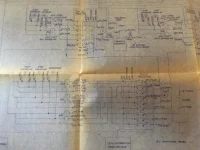My schematic is on the boat, but there was enough of yours to figure out what is connected when.
S5 drives S1/S2, not the other way around.
The AC breaker panel at the bottom has three inputs. L1, L2 and N. The 110v breakers on the left side are connected to L1 and N (giving 110v). The 110v breakers on the right side are connected to L2 and N (giving 110v). The 220v breakers at the bottom are connected to L1 and L2 (giving 220v). The 110v breakers and 220v breakers are all part of the same bus, they are not separate.
The distribution switches S1, S2 and S5 determine how L1 and L2 are powered. N is connected throughout the boat.
S1 determines if L1 is coming from the 220v source (S5), the port side 110v cord or the stbd side 110v cord.
S2 determines if L2 is coming from the 220v source (S5), the port side 110v cord or the stbd side 110v cord.
IF you are using a 220v source, then S5 determines if that source is the generator, the port side 220v cord or the stbd side 220v cord.
If you are using a 220v source, the flow is S5 to S1/S2 to AC breakers.
If you are using a 110v source, the flow is S1/S2 to AC breakers. (S5 doesn't matter).
The neutrals from all of these sources are tied together after the switches. On a boat, the ground is also connected to neutral.
Thus, you can have the following configurations.
1. The generator.
2. A 220v cord on either the port or stbd side (but not both).
3. Two 110v cords on either the port or stbd side.
4. One 110v cord on the port side and one 110v cord on the stbd side (different socket).
Obviously, options (1) & (2) will give you both 110v and 220v service. Options (3) & (4) will give you 220v service if the two 110v cords are out of phase.
If the two 110v cords are in phase, then you will not get 220v, however, the lines are still hot (meaning you can still get shocked), thus, I would flip the 220v breaker to off at the center bottom in that scenario. That way none of the 220v outlets in the boat will be hot, even though non functional.
One of the main design criteria of S1, S2 and S5, is that no source can (accidentally) be connected to another source, which would cause a major short. I would never have both 220v and 110v cords connected at the same time, but if you did, there is no switch combination (S1,S2 and S5) that would short them together. They could have done all of this distribution with no switches at all and just tied the L1, L2 and N directly to the plugs, and that would work as long as you only used the right combination of plugs at one time. Use the wrong combination, and poof. The only caveat to that is that you would NEVER want the generator connected with any shore power. So that would definitely require a transfer switch.
Also, while the whole boat shares a common neutral, that neutral is only connected to the appropriate source according to S1, S2 and S5. In other words, the sources are entirely isolated when not selected.



